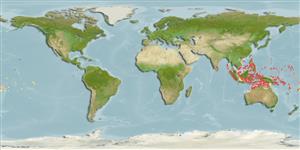Teleostei (teleosts) >
Ophidiiformes (Cusk eels) >
Bythitidae (Livebearing brotulas)
Etymology: Ematops: Name from Greek 'ichthy-emata' = fish-scale and 'ops' = face, eye; referring to the unique partial covering of the eye by head scales, which is not known in any other living ophidiiform fish..
More on authors: Cohen & Wourms.
Environment: milieu / climate zone / depth range / distribution range
Ecology
Marine; reef-associated; depth range 30 - 38 m (Ref. 34024). Tropical
Indo-Pacific Ocean: Philippines south to Indonesia including Papua New Guinea; Christmas Islands, Samoa and Vanuatu.
Size / Weight / Age
Maturity: Lm ? range ? - ? cm
Max length : 4.2 cm SL male/unsexed; (Ref. 34024)
Rare species, found near reef-sand interface (Ref. 34024). A 3.8 cm SL female specimen found to be gravid (Ref. 34024). Cryptic and solitary (Ref 90102).
Life cycle and mating behavior
Maturity | Reproduction | Spawning | Eggs | Fecundity | Larvae
Schwarzhans, W. and J.G. Nielsen, 2011. Revision of the genus Microbrotula (Teleostei: Bythitidae), with description of two new species and a related new genus. The Beagle, Records of the Museums and Art Galleries of the Northern Territory 27:147-160. (Ref. 88975)
IUCN Red List Status (Ref. 130435)
Threat to humans
Harmless
Human uses
Fisheries: of no interest
More information
Common namesSynonymsMetabolismPredatorsEcotoxicologyReproductionMaturitySpawningSpawning aggregationFecundityEggsEgg development
ReferencesAquacultureAquaculture profileStrainsGeneticsElectrophoresesHeritabilityDiseasesProcessingNutrientsMass conversion
Tools
Special reports
Download XML
Internet sources
Estimates based on models
Preferred temperature (Ref.
123201): 25.2 - 28.2, mean 27.6 °C (based on 16 cells).
Phylogenetic diversity index (Ref.
82804): PD
50 = 1.0000 [Uniqueness, from 0.5 = low to 2.0 = high].
Bayesian length-weight: a=0.00457 (0.00179 - 0.01169), b=3.10 (2.87 - 3.33), in cm total length, based on LWR estimates for this (Sub)family-body shape (Ref.
93245).
Trophic level (Ref.
69278): 3.2 ±0.5 se; based on size and trophs of closest relatives
Resilience (Ref.
120179): Low, minimum population doubling time 4.5 - 14 years (Assuming Fec < 100).
Fishing Vulnerability (Ref.
59153): Low vulnerability (10 of 100).
